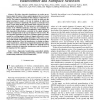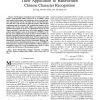1086 search results - page 17 / 218 » Subspace Analysis Using Random Mixture Models |
ICCV
2007
IEEE
14 years 9 months ago
2007
IEEE
Most existing subspace analysis-based tracking algorithms utilize a flattened vector to represent a target, resulting in a high dimensional data learning problem. Recently, subspa...
TSP
2008
13 years 7 months ago
2008
Abstract--We derive eigenvalue beamformers to resolve an unknown signal of interest whose spatial signature lies in a known subspace, but whose orientation in that subspace is othe...
TFS
2008
2008
Type-2 Fuzzy Markov Random Fields and Their Application to Handwritten Chinese Character Recognition
13 years 7 months ago
In this paper, we integrate type-2 (T2) fuzzy sets with Markov random fields (MRFs) referred to as T2 FMRFs, which may handle both fuzziness and randomness in the structural patter...
BMCBI
2008
13 years 7 months ago
2008
Background: In addition to their use in detecting undesired real-time PCR products, melting temperatures are useful for detecting variations in the desired target sequences. Metho...
TASLP
2010
13 years 2 months ago
2010
This article addresses the modeling of reverberant recording environments in the context of under-determined convolutive blind source separation. We model the contribution of each ...


